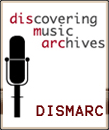
Objectives
The main objective of the DISMARC project is to support the discovery and dissemination of knowledge and information within the EU. The improvement in visibility of content is accompanied by heightened discovery, use and re-use by those in the academic community, the general public and the media.The project addresses problems of interactivity between different systems, which are mainly caused by varying methods of metadata description. We use existing software tools to map fields from each database onto a project-defined standard format. The DISMARC solution is simple enough to adopt as future best practice.
The TEL-Technology uses OAI-PMH (Open Archives Initiative – Protocol for Metadata Harvesting, http://www.openarchives.org ) which is a client-server protocol consisting of two components: an OAI-data provider and an OAI harvester. The OAI-Harvester collects from connected OAI data provider metadata (based normally on the Dublin Core metadata set) and copies the harvested metadata into a centrally-held database. This database can be indexed and allows searching, which means that metadata from all connected data providers are searched. The DISMARC system provides an OAI data provider which contains metadata from all DISMARC partner archives. All DISMARC metadata are exposed to be harvested by the TEL-harvester and copied onto the central TEL-System which allows integration of the DISMARC-metadata into the overall system (indexing, searching, browsing). By this means DISMARC metadata (coming from all partner catalogues) can be searched simultaneously together with all other TEL catalogues’ metadata.
Our tools use open standards to encourage others to take note of and to enable easy adoption of our proposed strategy, where the task is the mapping of existing data rather than the creation of new data.
The project facilitates access to European digital content by:
- providing a unified, one-stop internet browser that addresses
the catalogue data of various, distributed databases simultaneously;
- enabling searches of partners content to be made and for results
to be returned in various languages;
- establishing an expandable and scaleable metadata-mapping strategy
that is transferable to other institutions, museums and archives;
- adoption and utilisation of existing metadata standards rather
than the creation of another standard, by mapping and extension
of the existing metadata formats and vocabularies;
- creating a network among the partners which focuses on
mutual co-operation and heightening awareness of emerging metadata
standards, requirements and practices.
